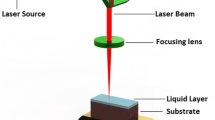Abstract
Laser beam micromachining (LBMM) process is one of the important advanced manufacturing processes which can shape almost all engineering materials with micron scale precision even for complex geometries. LBMM process when performed in air generates high heat flux causing thermal damage and poor surface finish on the substrate material. Liquid-assisted laser beam micromachining is considered as an alternate approach to the traditional laser beam micromachining process performed under air to reduce the thermal damages caused due to high heat of laser. The presence of liquid medium also helps in carrying away the molten material from the machining zone thereby preventing re-deposition. The focus of this research is to understand the effect of critical process parameters involved in liquid-assisted laser beam micromachining using finite element simulation technique. The study revealed that the width (diameter) and depth of the heat-affected zone decreased considerably with water film thickness of 0.50 mm and higher. Further experimentation is used to validate the results of the simulation model. The experimental results closely matched with the predictions of the simulation study. Micromachining performed under thin films of water and ethylene glycol showed better surface finish as compared to machining performed without water. This suggests that the liquid medium occupies the void during material removal due to laser beam and helps reducing the thermal damage.
Similar content being viewed by others
References
Parandoush P, Hossain A (2014) A review of modeling and simulation of laser beam machining. Int J Mach Tools Manuf 85:135–145. https://doi.org/10.1016/j.ijmachtools.2014.05.008
Meijer J (2004) Laser beam machining (LBM), state of the art and new opportunities. J Mater Process Technol 149(1–3):2–17. https://doi.org/10.1016/j.jmatprotec.2004.02.003
Kuar AS, Doloi B, Bhattacharyya B (2006) Modelling and analysis of pulsed Nd:YAG laser machining characteristics during micro-drilling of zirconia (ZrO2). Int J Mach Tools Manuf 46(12–13):1301–1310. https://doi.org/10.1016/j.ijmachtools.2005.10.016
Krstulović N, Shannon S, Stefanuik R, Fanara C (2013) Underwater-laser drilling of aluminum. Int J Adv Manuf Technol 69(5):1765–1773. https://doi.org/10.1007/s00170-013-5141-4
Li L, Achara C (2004) Chemical assisted laser machining for the minimisation of recast and heat affected zone. CIRP Ann Manuf Technol 53(1):175–178. https://doi.org/10.1016/S0007-8506(07)60672-6
Herzog D, Jaeschke P, Meier O, Haferkamp H (2008) Investigations on the thermal effect caused by laser cutting with respect to static strength of CFRP. Int J Mach Tools Manuf 48(12–13):1464–1473. https://doi.org/10.1016/j.ijmachtools.2008.04.007
Yang J, Sun S, Brandt M, Yan W (2010) Experimental investigation and 3D finite element prediction of the heat affected zone during laser assisted machining of Ti6Al4V alloy. J Mater Process Technol 210(15):2215–2222. https://doi.org/10.1016/j.jmatprotec.2010.08.007
Mahdieh MH, Nikbakht M, Eghlimi Moghadam Z, Sobhani M (2010) Crater geometry characterization of Al targets irradiated by single pulse and pulse trains of Nd:YAG laser in ambient air and water. Appl Surf Sci 256(6):1778–1783. https://doi.org/10.1016/j.apsusc.2009.10.003
Kazakevich PV, Simakin AV, Voronov VV, Shafeev GA (2006) Laser induced synthesis of nanoparticles in liquids. Appl Surf Sci 252(13):4373–4380. https://doi.org/10.1016/j.apsusc.2005.06.059
Garcia-Giron A, Sola D, Peña J (2016) Liquid-assisted laser ablation of advanced ceramics and glass-ceramic materials. Appl Surf Sci 363:548–554
Wang H, Lin H, Wang C, Zheng L, Hu X (2017) Laser drilling of structural ceramics—a review. J Eur Ceram Soc 37(4):1157–1173. https://doi.org/10.1016/j.jeurceramsoc.2016.10.031
Teixidor D, Ferrer I, Ciurana J, Özel T (2013) Optimization of process parameters for pulsed laser milling of micro-channels on AISI H13 tool steel. Robot Comput Integr Manuf 29(1):209–218. https://doi.org/10.1016/j.rcim.2012.05.005
Alahmari AM, Ahmed N, Darwish S (2016) Laser beam micro-machining under water immersion. Int J Adv Manuf Technol 83(9):1671–1681. https://doi.org/10.1007/s00170-015-7699-5
Bharatish A, Narasimha Murthy HN, Anand B, Madhusoodana CD, Praveena GS, Krishna M (2013) Characterization of hole circularity and heat affected zone in pulsed CO2 laser drilling of alumina ceramics. Opt Laser Technol 53:22–32. https://doi.org/10.1016/j.optlastec.2013.04.010
Choo KL, Ogawa Y, Kanbargi G, Otra V, Raff LM, Komanduri R (2004) Micromachining of silicon by short-pulse laser ablation in air and under water. Mater Sci Eng A 372(1–2):145–162. https://doi.org/10.1016/j.msea.2003.12.021
Tangwarodomnukun V, Likhitangsuwat P, Tevinpibanphan O, Dumkum C (2015) Laser ablation of titanium alloy under a thin and flowing water layer. Int J Mach Tools Manuf 89:14–28. https://doi.org/10.1016/j.ijmachtools.2014.10.013
Lima MM, Monteiro R (2001) Characterisation and thermal behaviour of a borosilicate glass. Thermochim Acta 373(1):69–74. https://doi.org/10.1016/S0040-6031(01)00456-7
Author information
Authors and Affiliations
Corresponding author
Rights and permissions
About this article
Cite this article
Mistry, V., James, S. Finite element analysis and simulation of liquid-assisted laser beam machining process. Int J Adv Manuf Technol 94, 2325–2331 (2018). https://doi.org/10.1007/s00170-017-1009-3
Received:
Accepted:
Published:
Issue Date:
DOI: https://doi.org/10.1007/s00170-017-1009-3




